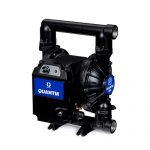Pneumatic diaphragm pumps are essential equipment in several industrial sectors, principalmente por sua capacidade de lidar com uma ampla variedade de fluidos, desde substâncias viscosas até produtos corrosivos. Contudo, a escolha e a correta configuração dessas bombas são fundamentais para garantir a sua total eficiência e longevidade no uso. A seguir, apresentamos um guia prático com as melhores práticas para selecionar e configurar a sua bomba pneumática de diafragma.
1. Avaliar a Aplicação
Before choosing a pneumatic diaphragm pump, it is essential to understand the specific application in which it will operate. This involves detailed analysis of the fluid type, operating conditions and performance requirements. To do this, consider the following factors:
- Fluid viscosity: High viscosity liquids require pumps with greater suction and pressure capacity.
- Presence of solids: The presence of solids in the fluid may require a pump capable of handling particles without causing blockages.
- Temperature: The compatibility of the pump with the temperature range of the fluid that will be pumped is essential to avoid damage to components.
- Flow and pressure requirements: Determine the required flow rate and outlet pressure for correct pump sizing.
2. Selection of Materials
Pneumatic diaphragm pumps are available in various materials, each suitable for different types of fluids and environmental operating conditions. Choosing the correct material is essential for the durability and performance of the pump. Common materials include:
- Aluminum: Suitable for non-corrosive, low-temperature fluids viscosity.
- Stainless steel: Ideal for corrosive liquids and environments that require high corrosion resistance.
- Polypropylene and PVDF: Materials used for highly corrosive fluids or aggressive chemicals.
- Santoprene and Good-N: Recommended for applications with abrasive or very acidic fluids.
3. Sizing
Proper sizing of the pneumatic diaphragm pump is essential to ensure that it meets the needs of the application without causing system overload. Key aspects that must be considered include:
- Flow Capacity: The amount of fluid the pump can move in a given period of time, as the pump must provide the required flow without overloading the system.
- Discharge pressure: The pressure to move the liquid through the system must be sufficient to overcome all resistance in the equipment piping system.
- Energy efficiency: More efficient pumps consume less energy, reducing long-term operating costs.
4. Pump Setup
After choose pneumatic diaphragm pump properly, correct configuration is essential to optimize performance and durability. This involves:
- Correct installation: The pump must be installed in accordance with its specifications, which are provided by the manufacturer, in order to avoid operational problems.
- Regular maintenance: Preventive maintenance is essential to increase pump life and avoid unexpected failures. This includes performing regular inspections and replacing worn parts before they cause problems.
- Operational adjustments: Setting the pump to operate within the manufacturer's recommended parameters helps prevent failures and maximize efficiency.
The appropriate choice and configuration of a pneumatic diaphragm pump is a complex process, but fundamental to ensuring efficient performance and longevity of the equipment. Understanding the application, selecting materials compatible with the fluid, correctly sizing and configuring the pump according to the manufacturer's recommendations are essential steps for success. In the next part of this guide, we will provide advanced details on setting up and maintaining pneumatic diaphragm pumps.
Know the Double Diaphragm Pneumatic Pumps – Husky 2200 – Graco










